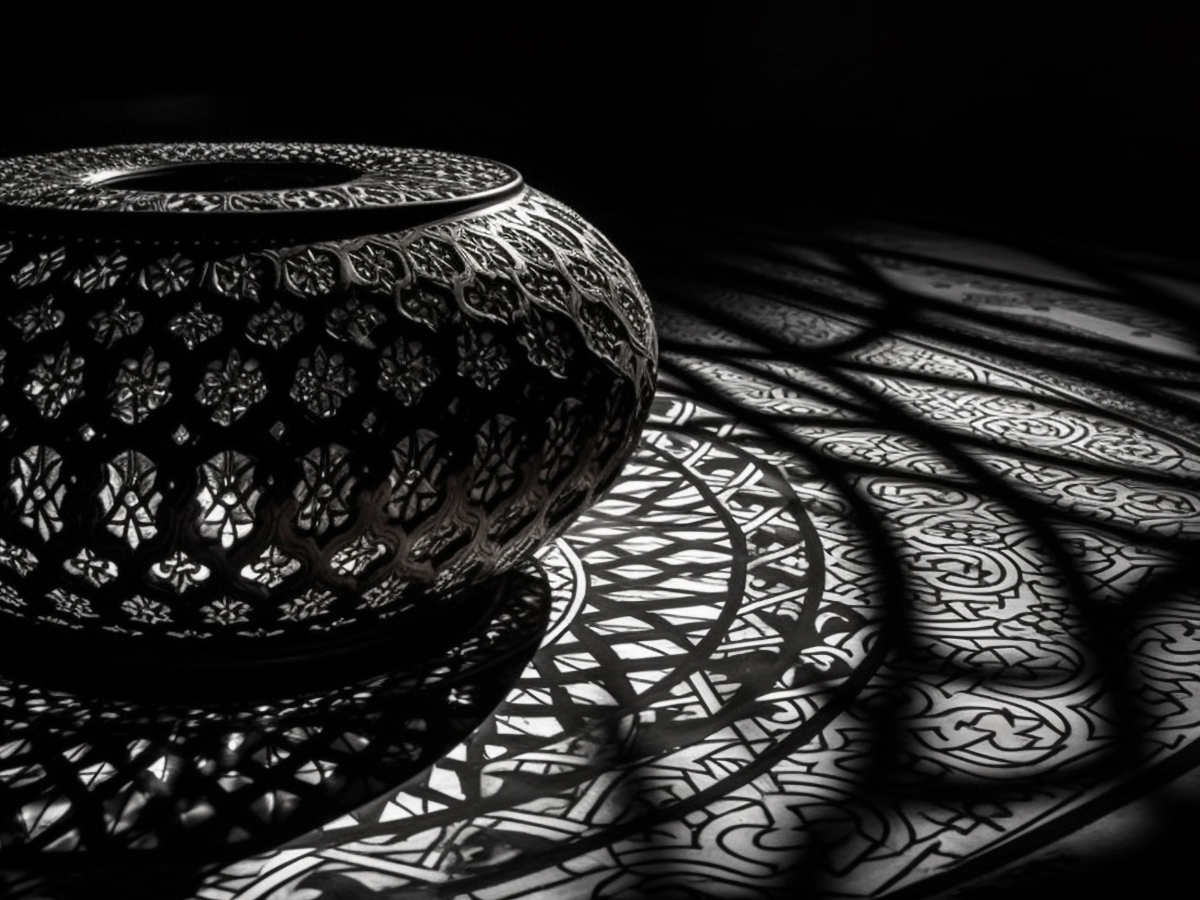Step into a mesmerizing world where history, art, and mathematics intertwine seamlessly, unveiling the captivating allure of Islamic Art behind Islamic Geometric Patterns. Brace yourself for an enchanting journey that transcends time and space as we delve into the depths of this ancient art form that has mesmerized generations. In this fascinating exploration, we will unravel the rich tapestry of Islamic culture, tracing its roots through centuries of intricate craftsmanship, divine inspiration, and ingenious mathematical precision. So, fasten your seatbelts, for we will embark on a voyage into Islamic geometric patterns. This realm promises to transport you to a realm of wonder and awe. Welcome to the fascinating history and art behind Islamic geometric patterns, where beauty and complexity intertwine to create a sight that will leave you spellbound.
Islamic art, with its mesmerizing and intricate geometric patterns, has been a source of fascination for many individuals throughout history. Muslim design is characterized by using geometric shapes such as circles, squares, and triangles to create complex compositions that are visually stunning and deeply symbolic. Arabic design often features arabesque art that uses scrolling floral motifs and geometric patterns. These designs can be found in traditional Islamic architecture, textiles, ceramics, and metalwork. Exploring the use of these patterns allows us to delve deeper into the rich cultural heritage of Islamic civilization while also gaining an appreciation for their mastery of mathematics and geometry. The combination of symmetry and asymmetry within these designs creates a sense of balance that resonates with viewers on multiple levels – from aesthetic pleasure to spiritual symbolism. In essence, understanding the significance behind each element used in creating these masterpieces offers an opportunity to appreciate their beauty and cultural importance across periods beyond what we usually see today.

The Sacred Symbols & Their Meaning Hidden Within Islamic Geometric Patterns
Islamic geometry patterns meaning is a complex and multifaceted topic. Geometric design in Islamic art has been used throughout history to create intricate and aesthetically pleasing designs that represent God’s unity and various other religious and cultural beliefs. The shapes in Islamic art are carefully chosen for their symbolic value, with each pattern representing something unique. For example, the star-shaped geometric pattern represents light and guidance, while the square symbolizes stability and balance. These symbols are not only visually stunning but also hold great spiritual significance. Moreover, many of these geometric designs can be found in mosques or other religious buildings, which adds a layer of importance to them as they serve as visual representations of faith for communities worldwide. By understanding the meanings behind these sacred symbols hidden within Islamic geometric patterns, we can gain a deeper appreciation for this beautiful form of artistic expression that inspires awe in people from all walks of life.
How the Different Styles of Islamic Geometric Patterns Evolved Across Different Cultures & Periods
The evolution of Islamic geometric patterns is a testament to the rich cultural heritage passed down through generations. Arabesque designs, with their intricate interlacing foliage and floral motifs, are believed to have originated in 9th-century Baghdad. They quickly spread throughout the Islamic world and were embraced by various cultures, each adding their unique touch to these ornate designs. Moroccan tile patterns, for instance, draw on many influences, such as Andalusian architecture and Berber artistry. Their use of bold colors and shapes creates an unmistakable visual impact that has stood the test of time. Persian mosaic tile designs also have a long history dating back to the Achaemenid Empire in ancient Iran. Incorporating calligraphy into these mosaics emphasizes their religious significance and elevates them as artistic masterpieces.
Overall, it’s fascinating how these styles evolved in response to cultural changes or political events. What started as simple geometrical shapes transformed into complex patterns infused with spiritual symbolism, reflecting more profound philosophical beliefs held by Islamic scholars at different historical periods. Today, they continue to inspire artists across all mediums, from fashion designers seeking inspiration for textiles or home decor enthusiasts looking for unique ways to elevate their living spaces – reminding us that even centuries-old traditions can still speak volumes about our shared humanity today!
Examples of Traditional & Modern Applications of Islamic Geometry Designs
Islamic geometry designs have been a source of inspiration for both traditional and modern applications. Traditional geometric pattern paintings like zellige tiles, muqarnas, and girth patterns made from intricate lines and shapes adorned Islamic architecture during the golden age of Islamic civilization. On the other hand, modern mosaic wall decor ideas incorporate these traditional designs in contemporary settings with bold colors, larger scales, and innovative materials such as glass or metallic finishes. With advancements in technology and design tools available today, designers are exploring new ways to reinterpret traditional vs. modern arabesque designs that blend cultural heritage with a fresh perspective. From minimalist wall art to ornate window screens or furniture accents – Islamic geometry is versatile enough to create timeless pieces that reflect the beauty of this ancient discipline while fitting any style or space requirement effortlessly.
How to Create Your Own Uniquely Beautiful Islamic Pattern Artwork
If you want a creative way to decorate your home with Islamic art, consider creating uniquely beautiful artwork using modern mosaic wall decor ideas and traditional geometric pattern paintings. One of the most distinguishing features of Islamic art is its use of intricate designs and patterns, which can be found in everything from architecture to textiles. To create your piece, start by researching traditional vs. modern arabesque designs and selecting a way that speaks to you. Then, choose colors that complement the overall aesthetic you want to achieve. Once you have decided on a design and color scheme, transfer it onto canvas or paper using stencils or sketching freehand. Consider adding texture by layering materials like gold leaf or metallic paint onto the surface. The result will be an eye-catching piece of art that combines both tradition and innovation in its execution.
In conclusion, Islamic geometric patterns’ captivating history and exquisite artistry weave a tapestry of fascination that has enchanted minds throughout the ages. Like a shimmering kaleidoscope of mathematical precision and artistic brilliance, these patterns stand as a testament to the ingenuity and creativity of Islamic artisans.
Islamic geometric patterns have adorned mosques, palaces, and the pages of ancient manuscripts through the ages, mesmerizing all who beheld them. With their intricate symmetries and harmonious designs, these patterns not only please the eye but also hold profound symbolism and spiritual significance.
Rooted in the rich Islamic heritage, these mesmerizing patterns draw inspiration from nature, astronomy, and mathematical principles. They reflect the belief in the unity and order of the universe, with every line, curve, and shape meticulously crafted to create a mesmerizing balance of form and function.
Islamic geometric patterns are not mere decorative motifs; they are a visual language that communicates the interconnectedness of all things. These patterns embody the fundamental Islamic values of unity, harmony, and the pursuit of knowledge, inviting us to contemplate the divine beauty and wisdom that permeate our world.
As we delve into the history of Islamic geometric patterns, we uncover the remarkable contributions of Islamic scholars, mathematicians, and artisans who pioneered the exploration of intricate geometries. They painstakingly refined their craft, delving into the depths of mathematical principles to create awe-inspiring designs that continue to inspire awe and admiration today.
From the mesmerizing star patterns of the Alhambra in Spain to the mesmerizing domes of the Sheikh Lotfollah Mosque in Iran, Islamic geometric patterns stand as enduring testaments to the incredible artistic and architectural legacy of the Islamic world. They serve as a bridge between the past and the present, reminding us of the boundless creativity and cultural exchange that have shaped our world.
As we explore the mesmerizing world of Islamic geometric patterns, we are invited to appreciate the beauty in precision, the elegance in symmetry, and the timeless allure of art that transcends cultural boundaries. Let us marvel at the intricate interplay of shapes and lines and let our imaginations take flight on the wings of these extraordinary designs.
In a world of diversity, Islamic geometric patterns beckon us to embrace the richness of different cultures, celebrate the power of human creativity, and find unity in the tapestry of our shared humanity. So let us continue to be captivated by the fascinating history and art behind Islamic geometric patterns, for they are a testament to the timeless beauty and the enduring legacy of human ingenuity.
